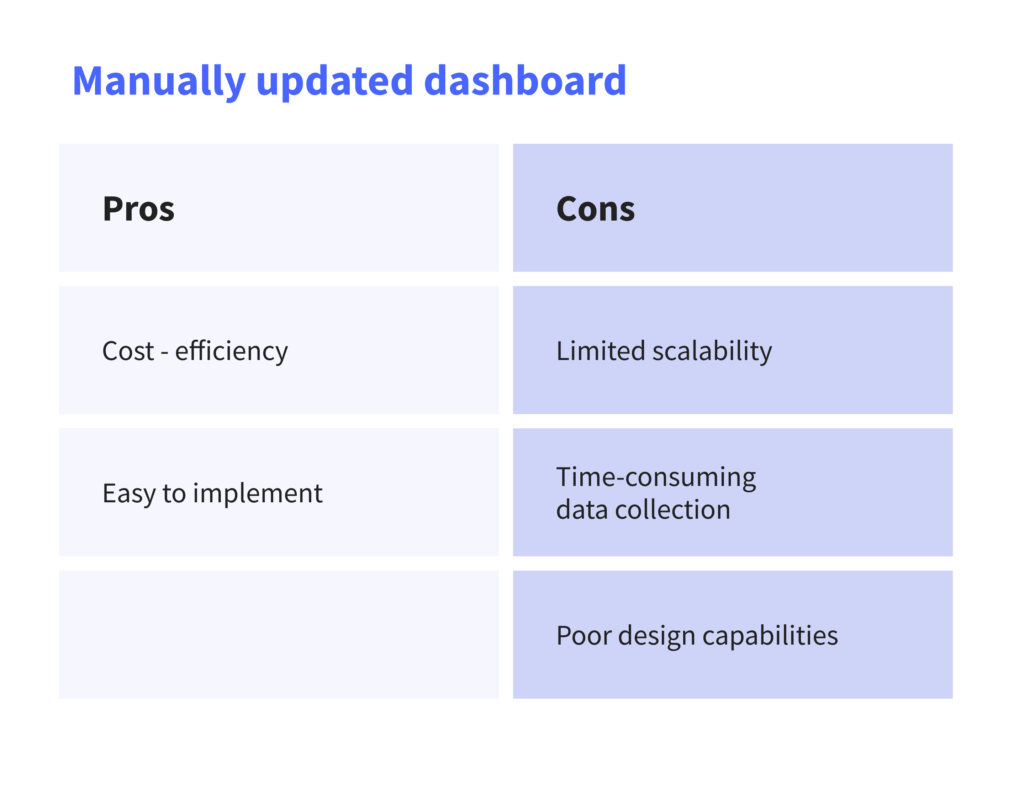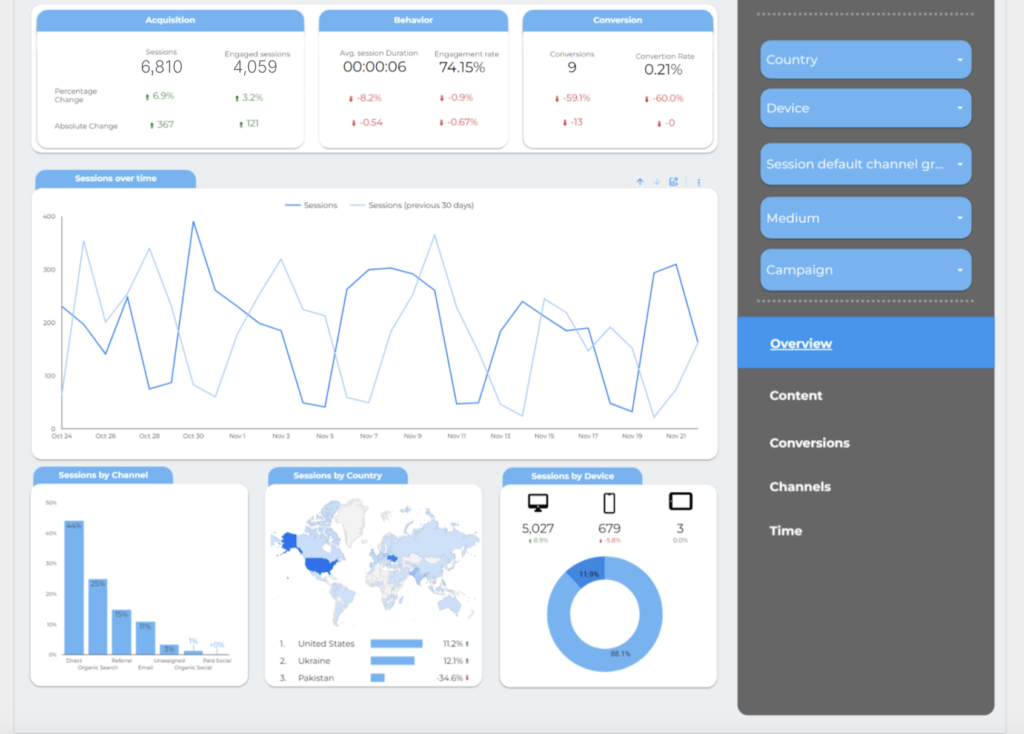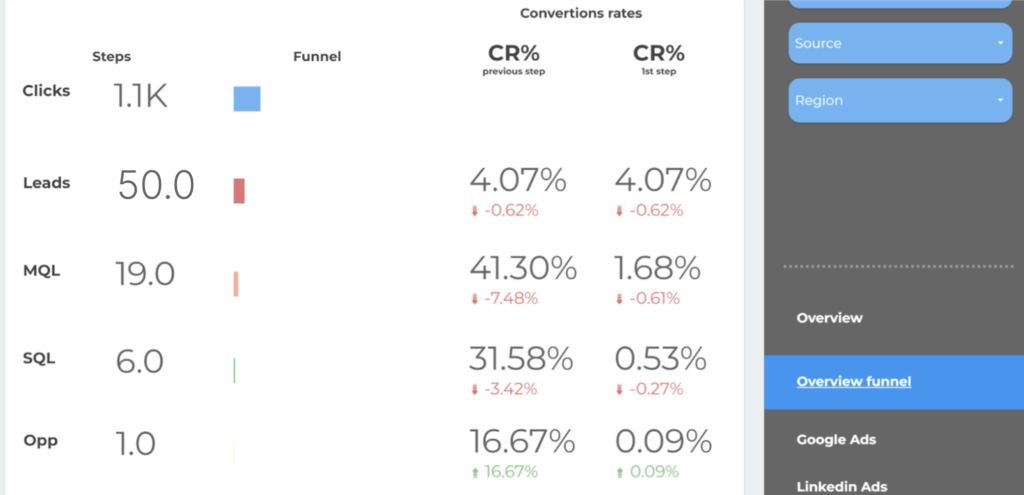Content Marketing Dashboard Guide + Key Metrics
Uncover the secrets to a successful content strategy through a meticulously crafted marketing dashboard.
Download Inbound Marketing guide
Are you looking to enhance the effectiveness of your content marketing strategy? The key to this is undoubtedly a well-structured marketing dashboard. Once you craft valuable content and publish it, your goal is to gain extensive insight into its performance.
In this guide, we will walk you through the building blocks of a comprehensive marketing dashboard for tracking content activities. You’ll also learn how to track and interpret important content marketing metrics, enabling you to make data-driven decisions that boost your strategy’s efficiency and ROI. Let’s dive in!

Key Components of a Marketing Dashboard
Integrating Content Marketing Metrics and KPIs
Metrics and KPIs are the heart of your dashboard. They help set up, track, and analyze marketing processes, allowing you to effectively measure the result of all content activities. Each provides insights about your content journey, from page views to social shares.
Dashboard Metrics: What to Include
A personalized dashboard is your accomplice in mastering content. We advise choosing metrics that matter to your strategic goals — think about what you want to achieve with your content and pick conversion points that align with these. Explore some great examples below!
- Day-to-Day Content Marketing Metrics
Let’s begin by focusing on the crucial content marketing metrics your team needs to keep an eye on daily. These typically include website customization, engagement, and conversion metrics. Monitoring these metrics is essential for comprehending how search engines rank your content, gauge its level of engagement with readers, and understand how it contributes to achieving your business objectives.

- Impressions
This metric reveals the visibility of your content to your audience. By keeping tabs on performance, you can pinpoint which content is gaining the most attention and understand what is making it more prominent in search engine results. Conversely, a significant drop in impressions might suggest that search engines do not perceive the content as informative or reliable. If this happens, revising and enhancing the content in line with the E-A-T principle is crucial.
- Clicks / CTR
This metric indicates the number of people who click on your content. Monitoring clicks helps you assess the appeal of your content’s title. If your content ranks well in SERP but isn’t attracting sufficient traffic, it might be time to craft a more compelling title. Refer to the chart provided as a benchmark for CTR for your content. Generally, the higher your article ranks on the SERP, the greater the expected CTR should be.
- Bounce rate
This metric indicates the proportion of visitors who exit your site after only viewing a single page. By monitoring this metric for each piece of content, you can pinpoint which articles are not sufficiently engaging or lack the necessary navigational features to extend the visitor’s journey on your website.
- Keyword ranking
This metric reveals the position of your content in search engine results for particular keywords. Understanding keyword rankings is vital for estimating the traffic each content piece drives to your website and comparing your content’s performance against that of your competitors.
Besides keeping an eye on your rankings, observing the keywords your competitors are ranking for is also beneficial. You might discover that they rank for keywords your blog has not addressed so far. If these keywords are relevant to your blog’s theme or website, you’ve just identified a new topic to explore, opening doors to increased traffic and lead generation.
- Number of backlinks by page
This metric tracks the count of external websites linking to your content. By observing this, you can discern which content pieces are most frequently shared and compare your backlink profile with those of your competitors.
Backlinks are a crucial factor in determining content ranking. Therefore, when creating new content, reviewing the number of backlinks that top-ranking articles have for your primary keyword is advisable. This information is essential for devising an effective link-building strategy for your content.
- Backlinks
Let’s delve deeper into backlinks, keeping in mind a crucial aspect: not all backlinks bring great results. Several factors, including the domain authority of the linking site, URL strength, the traffic volume of the linking domain, and relevance to the topic, influence the value of a backlink.
Consider this scenario: you’ve written an article about content marketing dashboards similar to this one. A backlink from a well-regarded platform like HubSpot would be far more influential than one from a standard guest-posting site for two main reasons:
Discuss your scaling with
42DM marketing advisor
Set up a call
- HubSpot is a recognized and credible marketing source that commands both authority and topic relevance. HubSpot typically generates higher traffic.
- Ahrefs is a useful tool that provides numerous metrics to evaluate the potential of backlinks from various websites and to gauge the robustness of your backlink profile. Integrating this data into your content marketing dashboard can help you consolidate all your content marketing data into a unified and reliable source.
- Average number of pages per session
This metric indicates the average number of pages viewed by a visitor in a single session. Monitoring this can help you determine the most engaging content pieces, allowing you to fine-tune your content strategy based on these insights.
Marketing Dashboard Examples (Content metrics)
Need some inspiration? Here are some examples of killer marketing dashboards that are a perfect match with our client’s goals!

Image caption: The 42DM example of a client dashboard
Utilizing a Content Marketing KPI Dashboard for Insightful Decision-Making
Moving on, let’s look at more advanced metrics that are ideal for inclusion in comprehensive marketing reports. These are typically shared with the board, Chief Marketing Officers (CMOs) or Vice Presidents (VPs) of Marketing.
- MQLs Attributed to Each Content Piece
The tracking of qualified leads is just as crucial as monitoring revenue. Instead of merely showcasing which content pieces generate the most leads, delve deeper by categorizing these leads. This approach allows your dashboard to differentiate which content is favored by small businesses versus those appealing to larger enterprises. This information is valuable for evaluating the return on investment (ROI) of your content marketing and for tailoring your content to better suit the preferences of your target audience.

- Digital Velocity
The digital velocity metric provides insight into the rate at which leads progress from initial contact to the converted stage. By tracking this, you’ll understand which content pieces attract audiences who are more informed about your product and inclined to purchase.
Final thoughts
Creating a comprehensive marketing dashboard that allows for proper monitoring can really pay off. With the right metrics and tools, you’re equipped to make data-driven decisions that will take your content marketing strategy to new heights.

Mary will discuss your business needs, goals, and expectations with you.
Liking what you’re reading?
Subscribe for moreRead more of our blog
Reach new heights
Let's find the best mix of services to cover your business needs.
